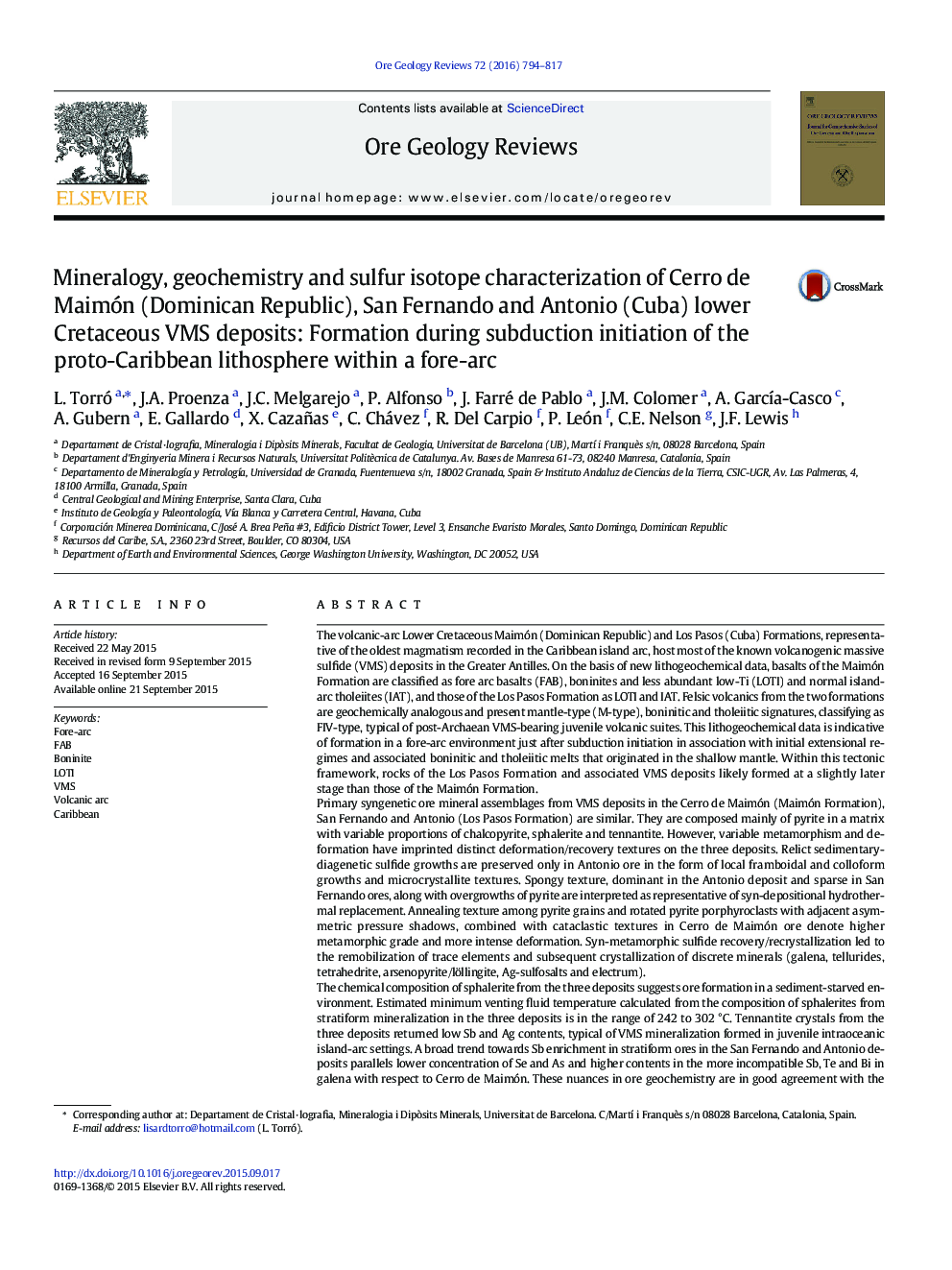| کد مقاله | کد نشریه | سال انتشار | مقاله انگلیسی | نسخه تمام متن |
|---|---|---|---|---|
| 6435802 | 1351852 | 2016 | 24 صفحه PDF | دانلود رایگان |

- This long manuscript gathers mineralogical and geochemical data on ore and hosting volcanic samples from the Dominican Cerro de Maimón and the Cubans San Fernando and Antonio VMS deposits.
- Lithochemistry of the hosting volcanics from the Maimón and Los Pasos Formations points to an exceptional record of the very first magmatic expressions connected to the subduction initiation of an intraoceanic case.
- The joint study of the VMS mineralizations hosted in both Formations are an appealing opportunity to describe and understand VMS mineralizing systems linked to the most primitive arc volcanism in fore-arc settings.
The volcanic-arc Lower Cretaceous Maimón (Dominican Republic) and Los Pasos (Cuba) Formations, representative of the oldest magmatism recorded in the Caribbean island arc, host most of the known volcanogenic massive sulfide (VMS) deposits in the Greater Antilles. On the basis of new lithogeochemical data, basalts of the Maimón Formation are classified as fore arc basalts (FAB), boninites and less abundant low-Ti (LOTI) and normal island-arc tholeiites (IAT), and those of the Los Pasos Formation as LOTI and IAT. Felsic volcanics from the two formations are geochemically analogous and present mantle-type (M-type), boninitic and tholeiitic signatures, classifying as FIV-type, typical of post-Archaean VMS-bearing juvenile volcanic suites. This lithogeochemical data is indicative of formation in a fore-arc environment just after subduction initiation in association with initial extensional regimes and associated boninitic and tholeiitic melts that originated in the shallow mantle. Within this tectonic framework, rocks of the Los Pasos Formation and associated VMS deposits likely formed at a slightly later stage than those of the Maimón Formation.Primary syngenetic ore mineral assemblages from VMS deposits in the Cerro de Maimón (Maimón Formation), San Fernando and Antonio (Los Pasos Formation) are similar. They are composed mainly of pyrite in a matrix with variable proportions of chalcopyrite, sphalerite and tennantite. However, variable metamorphism and deformation have imprinted distinct deformation/recovery textures on the three deposits. Relict sedimentary-diagenetic sulfide growths are preserved only in Antonio ore in the form of local framboidal and colloform growths and microcrystallite textures. Spongy texture, dominant in the Antonio deposit and sparse in San Fernando ores, along with overgrowths of pyrite are interpreted as representative of syn-depositional hydrothermal replacement. Annealing texture among pyrite grains and rotated pyrite porphyroclasts with adjacent asymmetric pressure shadows, combined with cataclastic textures in Cerro de Maimón ore denote higher metamorphic grade and more intense deformation. Syn-metamorphic sulfide recovery/recrystallization led to the remobilization of trace elements and subsequent crystallization of discrete minerals (galena, tellurides, tetrahedrite, arsenopyrite/löllingite, Ag-sulfosalts and electrum).The chemical composition of sphalerite from the three deposits suggests ore formation in a sediment-starved environment. Estimated minimum venting fluid temperature calculated from the composition of sphalerites from stratiform mineralization in the three deposits is in the range of 242 to 302 °C. Tennantite crystals from the three deposits returned low Sb and Ag contents, typical of VMS mineralization formed in juvenile intraoceanic island-arc settings. A broad trend towards Sb enrichment in stratiform ores in the San Fernando and Antonio deposits parallels lower concentration of Se and As and higher contents in the more incompatible Sb, Te and Bi in galena with respect to Cerro de Maimón. These nuances in ore geochemistry are in good agreement with the slightly more primitive setting of formation of VMS mineralization hosted in the Maimón Formation, as indicated by the lithogeochemistry of the volcanic host rocks.The sulfides from Cerro de Maimón display δ34S values of â 1.3 to + 3.0â°, whereas those from the San Fernando and Antonio deposits were in the range of â 0.5 to + 7.0â° and of 0.0 to + 5.8â° respectively. The relatively narrow scatter of δ34S suggests homogeneous fluid sulfur composition and similar physico-chemical conditions during the ore forming processes, and is consistent with sulfide derived from the inorganic reduction of seawater and/or from a magmatic source.Although the three deposits are classified as non-auriferous, significant Au contents are described in Cerro de Maimón ore (to 7.6 g/t) and in intermediate (to 1.44 g/t) and upper (to 0.88 g/t) mineralized zones of the San Fernando deposit. Gold, probably precipitated as invisible gold during exhalative mineralization, shows evidence for later metamorphism- and deformation-triggered remobilization and re-precipitation as subordinate electrum. Solid-state mechanical transfer was apparently the dominant upgrading mechanism in the Cerro de Maimón deposit whereas liquid-state chemical transfer would have governed the upgrading process in the San Fernando deposit.
Journal: Ore Geology Reviews - Volume 72, Part 1, January 2016, Pages 794-817